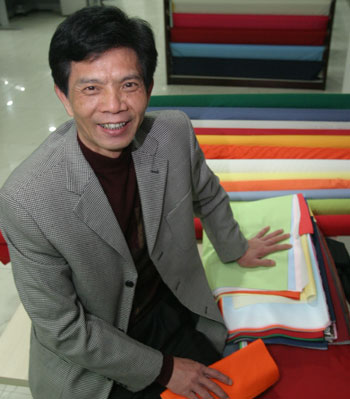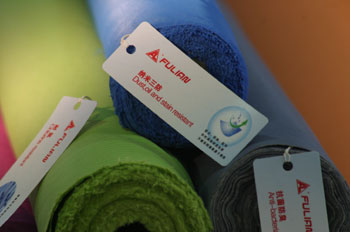
CHINA’S TEXTILE industry is entering a new era in 2008, according to industry insiders who are also expecting the nation to emerge as a net textile importer this year.
Even before the quota system for Chinese textile shipments to the European Union expired at end 2007, China has put woes of sanctions on textile exports to North America and Europe behind it by targeting the domestic market.
Output of finished products in 2007 is expected to reach Rmb 3.05 trillion, a 22 % increase y-o-y, according to a report released on 27 Dec 2007 by China National Textile and Apparel Council.
“Domestic demand for functional fabrics is increasing as China’s consumer economy changes structurally,” says the founder and executive chairman of synthetic fiber maker Foreland Fabritech Holdings Ltd (Apr 2007 IPO: 21 cents; Jan 15 '08: 53 cents), Mr Tsoi Kin Chit.
Foreland’s production lines have been operating at above 90% utilization since 2006.
China is currently a net importer of functional fabrics, and Mr Tsoi wants to gain market share from foreign manufacturers.
Foreland is capitalising on the industry upturn by investing some Rmb 128 million to double its production capacity.
Current capacity is 38.2 million yards a year. Another 30 million yards of capacity will be added with the purchase of Zhongshan Yisheng Knitting, Printing and Dyeing Co Ltd – a Guangdong textile factory complete with a wastewater treatment and methylbenzene recycling facility.
Four consumer segments driving textile demand
In the textile industry, apparel retailers appear to be the big winners in China's consumer revolution, followed by manufacturers able to weave fabrics with desired qualities, judging by gross margins along the supply chain. (See table 1 below)
Table 1: Gross margins at each stage of textile supply chain
| Listco | Stage of supply chain | Gross margins |
| C&G | 1. Functional Yarn | 26.2% |
| Foreland | 2. Functional Fabric | 37.5% |
| China Print & Dye | 3. Printing and Dyeing | 22% |
| People’s Garments Pcl (Thai-listed) | 4. OEM Garment manufacturer | 19% (EBITDA) |
| Zhejiang Baoxiniao (Shenzhen-listed) | 5. Retailer | 51% |
First and foremost, women's fashion apparel is expected to lead consumption demand, based on sales trends reported by departmental stores nationwide. High color-fastness in Foreland's fabrics makes the wearer look as though she is donning a brand new dress even after multiple washes.
Secondly, demand for sporting goods is likely to benefit from the hype over the Beijing Olympics 2008. Growth is projected to be 20% annually over the next five years. Sporting apparel made of air breathablility fabric sell at premium prices.
Thirdly, infant wear is expected to enter a golden era as 2007 saw yet another record-breaking year (China's 4th) for birthrate. Apparel retailers woo parents with Foreland's anti-bacteria fabric.
Last but not least, business apparel demand is expected to increase as the population of city dwellers increases. Urbanization in 2006 reached close to 20%. China's expenditure on men's shirts is 3.1% nationwide and 14.3% per capita compared to the US, suggesting huge growth potential as a result of rural-urban migration.
Consumer spending power is evident: traditional pre-dominance of the wholesale distribution channel is making way for the emerging retailer.
Garment manufacturers of sports, leisure and business apparel as well as textile traders in China buy fabrics from Foreland. Its fabrics are material for the apparel of popular sports apparel brands such as Li Ning, Edenbo and Anta.
1. Yarn (yarn may be knitted or weaved into loom-state fabric)
2. Dyes (loom-state fabric is immersed into dyes and subject to heat-treatment); and
3. Coating and finishing
Foreland weaves polyester and nylon fabrics from yarn spun by the likes of C&G Industrial (Apr 2005 IPO: 31 cents), also listed on SGX. Coating, dyeing and finishing are part of its production process.
Polyester is the most widely used manufactured fiber in the United States. Woven polyester fabrics are used for apparel and home furnishings. These include bed sheets, bedspreads, curtains and draperies. Polyester fiberfill is also used to stuff pillows, comforters and cushion padding.
Nylon is commonly used to make synthetic fabrics and women’s clothing.
About half of the fabrics sold by Foreland are functional fabrics. The other half comprises of normal fabrics. Its production process includes weaving, dyeing, coating and finishing of fabrics.
The fabric maker has seen a near doubling of sales each year (CAGR 93.7%) since FY2003.
It has no direct export sales.
Rmb 289.4 million worth of nylon and polyester fabrics were sold in the first nine months of 2007.

Reason: product mix had shifted toward functional fabrics and with higher grade over the years.
Gross margins have leaped a hefty 10 percentage points from 27.4% in FY03 to 37.5% in FY06 ever since diversifying its range of functional fabrics in 2003.
And margins are still widening. Gross profit margins for the first nine months of FY07 continued its steady rise to 38.4%. Wow!
FY03-06 net profit CAGR was as high as 161.5%.
Net margins were 23.8% from a profit of Rmb 69 million.
Foreland had its genesis producing fabrics for umbrellas. Mr Tsoi had founded the business in 1988 with 3 partners.
Faced with eroding margins of the umbrella fabric business at the turn of the century, Mr Tsoi’s partners wanted to sell off the umbrella fabric factory and focus on real estate, which was a segment of their business then.
Mr Tsoi, however, had a passion for fabric making. Spurning the financial prospects of the hot real estate sector, he bit the bullet by exchanging his stake in their joint real estate business for full ownership of the fabric factory.
After the split in 2003, Mr Tsoi roamed numerous trade fairs and exhibitions in South Korea, Taiwan and Japan, which had Asia’s most advanced technology in textile manufacturing.
| Functional Fabrics | Technology Partner |
Biodegradable compound | |
Anti-radiation | Taiwan Textile Research |
Anti-insect | Daiwa Chemical |
Cold Feel | Bayer |
Chlorine-resist | Bayer |
Anti-bacteria & odour | Ciba |
High color fastness | Zschimmer |
Combustion-resist | Ciba & Transfar Grp |
Moisture absorbent | Ciba |
Dust, oil and stain-resist | Ciba |
UV protection | Ciba |
Moisture & air breathability | Evermore Chemical |
| Table 2: Foreland's product offering |
Foreland then acquired brand new and technologically advanced equipment from
these nations – equipment that improved productivity and that could make functional fabrics.
Fabrics for apparel, bags and shoes became Foreland’s mainstay, as these were produced using technology commanding lucrative margins.
Mr Tsoi’s passion for the business is reflected in the company’s culture: it constantly improves on technology adopted from suppliers, which happen to be global chemical giants such as Ciba and Zschimmer.
Foreland has been relying on external technology when producing fabrics with a myriad of characteristics that apparel makers woo consumers by.
To address fierce competition, synthetic fiber manufacturers such as Foreland and C&G zealously roll out new technology to maintain margins.
”Widely used in sporting apparel, breathable fabric is now the biggest category in functional fabrics,” says Mr Tsoi.
Demonstrating one of the ‘functions’ of fabrics made by his company, Mr Tsoi pours water onto a piece of breathable fabric. Water seeps through pores on the breathable fabric without wetting it.
”Breathable fabrics not only need pores to allow ventilation, but also need to remain dry on its perspiring wearer,” explains Mr Tsoi.
Foreland's latest commercial breakthrough shows the fruit of dedication to innovation: proprietary membrane technology for biodegradable fabric weaved from a multi-million yuan South Korean machine.







